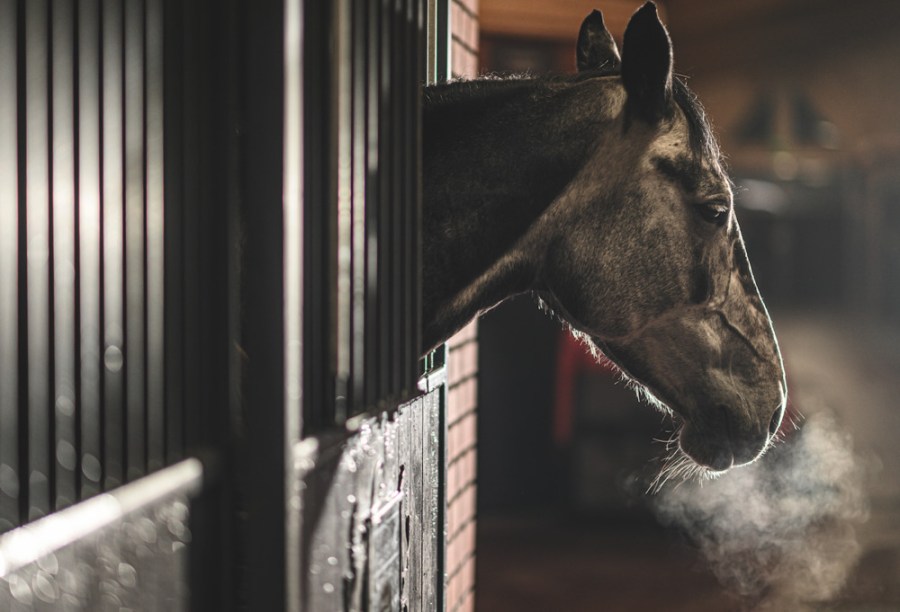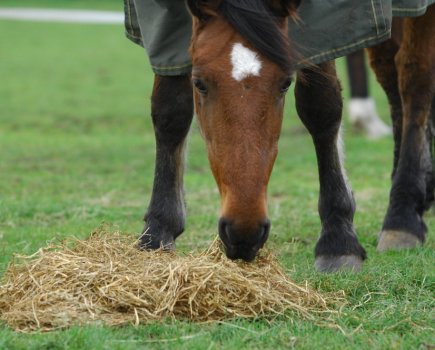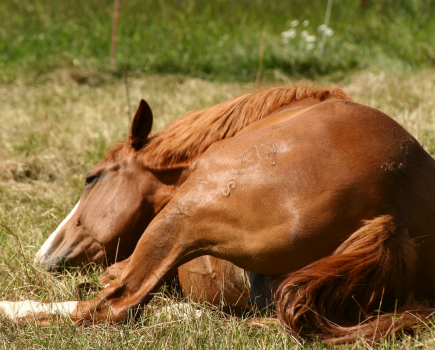Winter brings with it an array of conditions and ailments ready to blight our horses and trigger a run of poor health. They can strike quickly and suddenly, leading to a distressing time for both horse and owner, as well as a hefty vet bill at a time of year that is already expensive.
Wherever you live in the world, there are things you can do to help prevent your horse falling ill with a typical winter-induced ailment.
Here is a round up of the most common conditions I am called out to as an equine vet, including advice for how to prevent and manage them, plus the treatment your vet may recommend.
Vet call outs: equine asthma
Winter is often when I see more cases of equine asthma. Chronic obstructive pulmonary disease (COPD; also known as recurrent airway obstruction (RAO) and equine asthma), occurs when inhaled allergens initiate a cycle of airway constriction and airway inflammation.
Two forms commonly occur — summer asthma secondary to pollen, and the more renowned form triggered by dust. The latter occurs throughout the year, but is prevalent in winter when horses spend more time stabled.
Affected horses with equine asthma present with clinical signs of varying severity. Some merely have a history of poor performance or a mildly increased respiratory (breathing) rate, whereas others are more severely affected and present with respiratory distress.
Diagnosis is often based on the presence of clinical signs, but is confirmed following respiratory tractendoscopy and airway fluid samples.
With dust-induced asthma, management changes are of paramount importance. The affected patient should be out, breathing fresh air as much as possible. While stabled, minimising dust in the patient’s environment is crucial. I advise using dust-free bedding in the form of paper, cardboard or dust-extracted shavings.
Bedding should be laid without the horse present, and small amounts replaced daily. Cobwebs should be hoovered from the stable quarterly and grooming should also take place outside to minimise stable dust. If feeding hay, a hay steamer is ideal; otherwise, hay should be thoroughly soaked and fed prior to drying out.
Sometimes, management changes alone aren’t sufficient and medication is required. Airway inflammation is slow to resolve, and treatment may be required for a period of months. Drugs can be administered orally orby the inhalatory/nebulised routes.
Vet call outs: swollen sheaths
An unusual, but still fairly common winter condition I get called out to is a swollen sheath. More often than not, sheath swelling results from horses standing in for prolonged periods. Swelling should improve, if not resolve, with exercise/increased movement.
Other causes of swelling include excessive accumulation of smegma, low blood protein, infection and, fortunately less commonly, infection secondary to penile tumours. Fat can also accumulate in the sheath, but this has a more gradual onset.
In cases of excessive smegma, cleaning the sheath and penis is required, although sheaths should not be over cleaned as this can disrupt the sheath’s normal flora. Low blood protein can result from small encysted redworm and colitis, and diagnosis is made based on history and compatible clinical signs, as well as a blood test.
With infectious causes of swelling, the sheath is firm, hot and painful to touch. I will generally examine and clean the sheath and penis and prescribe antibiotics and anti-inflammatory medication.
Penile tumours are rare. The tumorous growths vary in appearance from small white plaques to large proliferative growths. Treatment options depend on the stage of the disease. Where possible ,surgical removal is the best option.
Vet call outs: rain scald
Rain scald is caused by the same bacterium that causes mud fever, Dermatophilus congolensis, but it generally affects the top of the horse’s body, in particular, the back.
Similar to mud fever, it occurs following prolonged wetting of the skin which is seen with increased frequency at this time of year. The resulting skin softening allows bacteria to enter, resulting in a dermatitis characterised by hair loss and crusting. Hair typically comes away in tufts bound by a scab.
Treatment is based on preventing further skin wetting and treating the lesions. I suggest clipping the surrounding hair, provided that this doesn’t result in additional trauma.
The infected area should be thoroughly cleaned using a dilute, warm chlorhexidine solution. Topical antimicrobials/anti-inflammatories (creams) may be prescribed by your vet in addition to systemic antimicrobials (oral/injectable) if indicated.
Vet call outs: mud fever
Mud fever is also caused by the bacterium Dermatophilus congonelsis. Similar to rain scald, bacteria gain entry to the skin of the lower limbs following skin softening induced by wet and muddy conditions. This results in scabbing, which subsequently peels off to leave red sores underneath. Occasionally, cellulitis (subcutaneous skin infection, see below) ensues.
Treatment involves removing the patient from the wet conditions and keeping him indoors until the lesions have healed. Gentle exercise in a clean, dry area is important to assist with limb swelling. Sand can be quite abrasive to distal limb sores and therefore, when open sores are present, exercise in a sand school should be avoided until the sores have healed.
In early, uncomplicated cases, topical treatment involving a combination of shampoos and creams is generally sufficient, but in more severe cases and those with secondary cellulitis, antibiotics and anti-inflammatories are required.
Vet call outs: cellulitis
Cellulitis can occur throughout the year secondary to trauma and wounds, but in winter it is more often seen secondary to mud fever scabs forming.
Affected horses develop lower limb swelling resulting in a lack of definition of the limb. The limb may be hot and painful to palpate, and the patient is sometimes lame. Treatment is based on addressing the cause, together with antibiotics, anti-inflammatories and exercise for the cellulitis.
Vet call outs: colic
It’s common for horses to experience a change in diet when they come in for the winter months, often swapping a grass-based diet for a hay/haylage-based one. Stabled horses are also more restricted movement-wise, which can reduce gut motility. This results in an increased incidence of impaction colic.
Impactions develop in the colon when food accumulates and dries out. Affected horses can present with signs of colic, reduced droppings and reduced appetite. Risk factors for impaction development include the dietary changes described above, reduced movement, decreased water intake (which can occur during cold spells when water freezes), dental abnormalities and tapeworm infection, to name but a few.
During cold, frosty periods it may be worth placing a tennis ball in your horse’s water bucket to help stop the water from freezing. You can read more about colic in horses here.
Vet call outs: mites
I most often see mites in the legs of feathered breeds, but they can be present in other breeds of horse too, more commonly in the facial area.
Mite infections can occur throughout the year, but as mite populations are highest in winter, this is the time of year when vets see the most clinical cases. Symptoms include itchiness and repeated stamping of feet, biting/chewing at feathers and scratching on various objects.
On closer examination, crusts and hair loss, with or without weeping lesions, are generally present. Some horses markedly object to examination of the lesions so care should be taken.
Diagnosis is confirmed by examining a skin brushing under the microscope, but diagnosis is often based on a compatible history and physical examination.
Treatment should ideally start with clipping. The limbs should then be bathed in a solution to soften and breakup the scabs/crusts prior to the application of a topical treatment.
There are many topical treatments on the market and an injectable treatment is also available. Following treatment, your horse’s stable should be thoroughly cleaned to prevent re-infection.








